-
Administrator

Article: Hollywood Sport Cars McLaren MkI
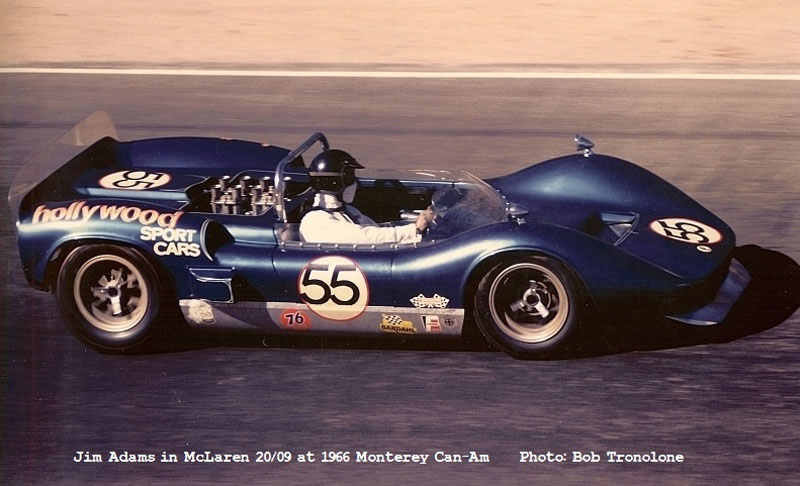
Doane Spencer was a California hot rodder who went road racing. In hot rodding circles, his famous black ’32 Ford roadster is considered one of the most significant and influential cars ever made. As a young war vet, returning home from the hostilities of WW2, he threw himself into the California hot rod scene, putting to good use the skills taught to him by the US government as they poured their vast resources into winning the war. Like the guys he knocked around with, such as Robert. E Peterson, Wally Parks, and Alex Xydias, who would all go on to play substantial roles in the hot rodding and automotive industries, Spencer thrashed his roadster up and down the dry lakes, and local California streets.
The beautiful Spencer roadster featured a number of tasteful modifications that would influence hot rodders for decades, including a sweeping Du Vall windshield, front frame horns lopped off at the radiator, engine-turned dash, and hand rolled fuel tank cover. But it wasn’t just a beauty-queen. It was also quick, and driven hard. Powered by a Mercury flathead V8, it clocked 126.76 mph at El Mirage dry lakes in the late 1940s.
But while his buddies fully embraced the hot rod scene, Spencer’s interests wandered to quite different challenges. In the early 1950s, he tore down the ’32, and began a major rebuild, in order to enter the car in the great Mexican road race, La Carrera Panamericana.
In setting about modifying the roadster for the Mexican road race, Spencer began fitting a Lincoln overhead-valve V8, from which the exhausts exited out through the sides of the frame rails to provide increased ground clearance. He beefed up the suspension, installed a quick-change rear-end, and a set of magnesium Halibrand wheels. However, before the rebuild could be completed, Carrera Panamericana was cancelled, and the incomplete ’32 was sold to Lynn Wineland, who worked for Rod & Custom magazine. It is now owned by Bruce Meyer, who purchased it in 1995, and had Pete Chapouris restore it. In 1997, Meyer was invited to enter it in the first ever Hot Rod class at the Pebble Beach Concours d’Elegance, where it won first place.
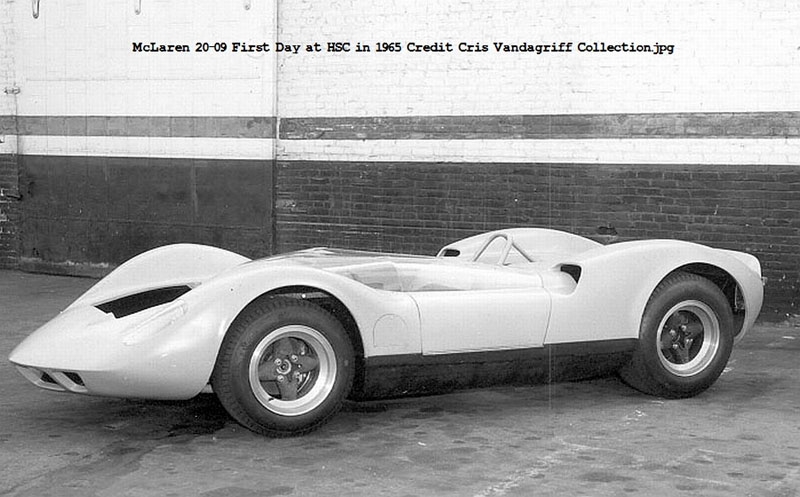
For a time in the 1950s, Spencer went to work for Xydias at the famous So-Cal Speed Shop, before branching away from hot rodding altogether with a move to Burbank Sports Cars. When fellow BSC employee Chic Vandagriff set out to establish Hollywood Sport Cars, he took Spencer with him. Hollywood Sport Cars specialised in buying and selling British and European cars, race preparation, and enhancing the performance of road cars.
HSC soon established a reputation for building and preparing some pretty rapid British and European sports cars for a growing clientele. This included the famous HSC Sunbeam Tiger, commissioned by Rootes Group for SCCA B-Production competition to help raise the Tiger’s profile in a market fixated with the Shelby Cobra. The little Tiger was an absolute terror in B-Production ranks, beating up on the numerous Cobra’s and Shelby GT350 Mustangs that had previously dominated the category. It was driven by Jim Adams with whom Spencer built a strong alliance, and who he entrusted to drive a number other cars over the coming years.
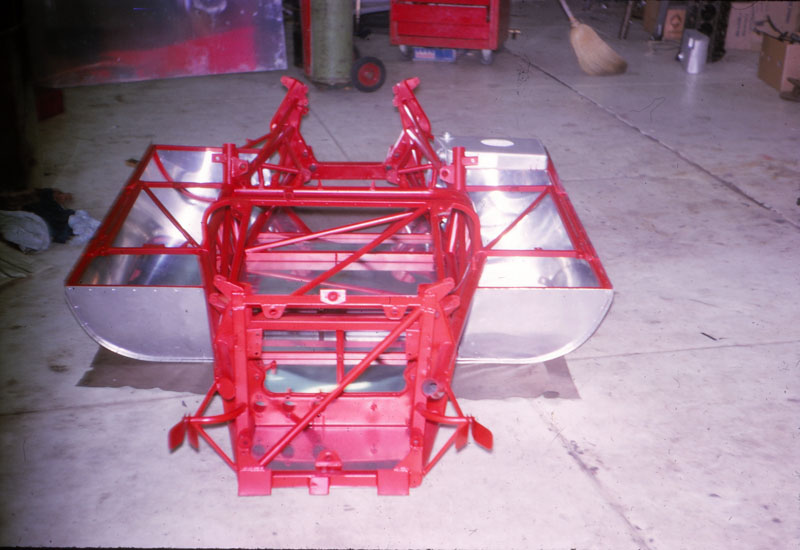
The Spencer prepped, Adams driven Tiger proved a tough act in 1965 SCCA B-Production ranks, and by mid-season had established a healthy points buffer in the championship. But when Adams broke his leg in a dirt bike incident, and was unable to drive, Spencer chose to park the Tiger until his steed could return, rather than put someone else at the helm. Rootes Group pushed to have Ken Miles drive the car, but Spencer argued the points accumulated thus far were enough they could return for the final round (with the recovered Adams) and still take the title. This decision ultimately sealed the fate of the Tiger’s 1965 championship, and Rootes relationship with HSC, when a gyrating Corvette slammed the Tiger and eliminated it from the race, with the championship also going up in smoke. But for 1966, HSC and Spencer had bigger fish to fry.
-
Administrator

I’ve long been fascinated by Doane Spencer, and his approach to building race cars. He had an uncanny knack (and the HSC Tiger was a good example of this), for somehow always improving the aesthetics of a car while also trying to improve its performance. But I don’t know if this was a conscious thing, that came from his early hot rodding days, or if it was just a natural side-effect of his drive improve on the standard fare. But somehow, in his efforts to make a car perform better, he also made it more pleasing to the eye.
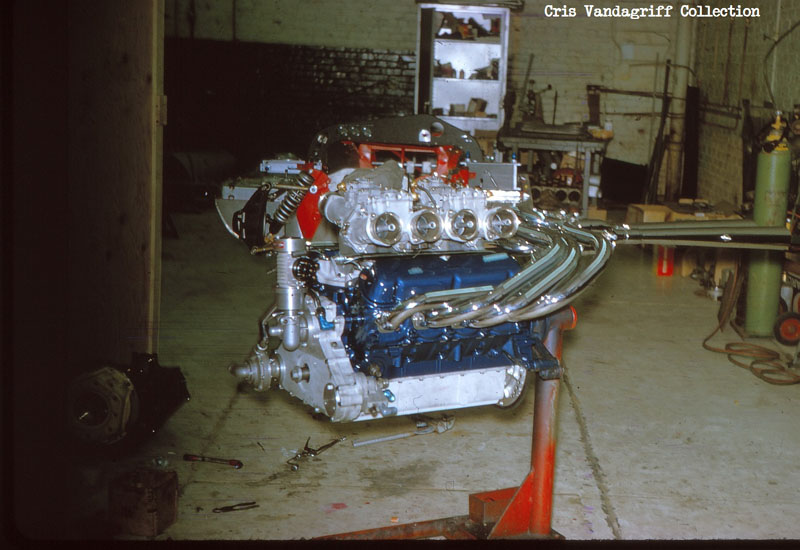
This was in evidence once again when the next vehicle arrived at Hollywood Sport Cars for Spencer to work his magic on. Vandagriff had just purchased a new McLaren-Elva MkI (chassis 20/09) from Carl Haas, with which to contest the United States Road Racing Championship, the newly announced Canadian-American Challenge Cup, and various other events in which Group 7 sports cars were invited. Immediately, Spencer set about making improvements to the McLaren, remodelling the front bodywork, the roll hoop, adding scoops to the rear bodywork to aid oil cooling, fitting Schroeder rack and pinion steering, pin-drive knock-off magnesium wheels (initially intricate ‘Star Of David’ wheels, followed by more traditional Halibrands), and his own cross-ram Webered 289ci Ford motor.
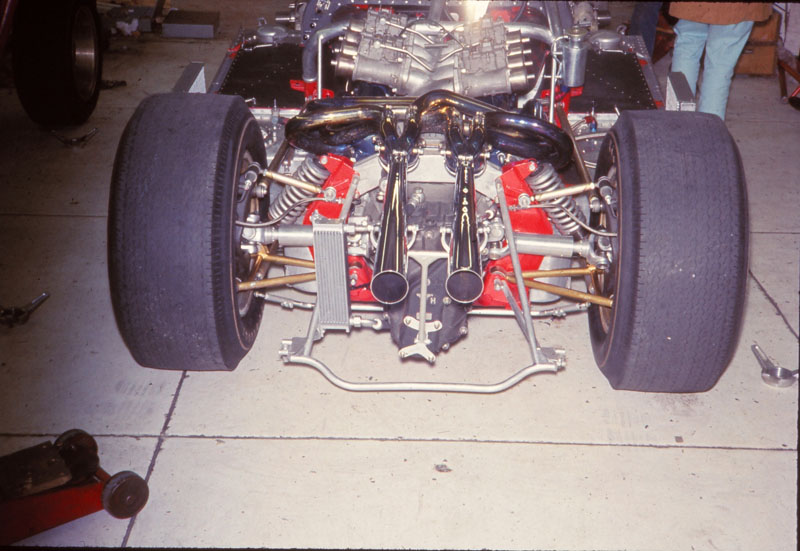
Underneath, he skinned the entire belly and lower sills/rockers/fuel cells in aluminium sheet, to help add strength and rigidity to the McLaren tube-chassis. Typically, Spencer’s modifications much improved the aesthetics of the McLaren, and his hot rodding roots were in evidence with beautifully finished paint work, over which fine pin-striping would later be added, plus chroming of the suspension. With the swoopy body removed, his attention to detail was unveiled for all to enjoy.
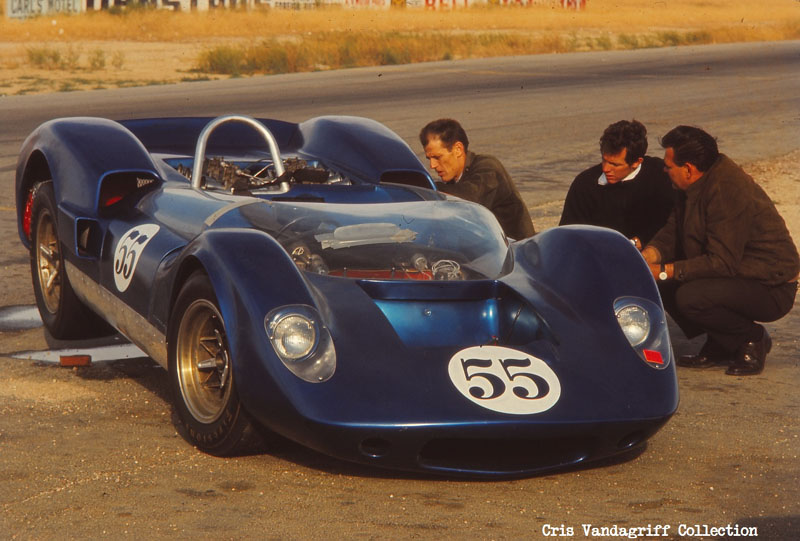
Frustratingly, however, just two months after HSC had taken stock of their MkI model, and following Spencer’s substantial efforts to improve on the basic McLaren offering, the new McLaren-Elva MkII (or M1B) was released. Much more than a simple model number designation to further boost sales, the MkII featured significant changes and upgrades over the MkI, including heavy revisions to the front bodywork. And so, once again, Spencer set to work, making further changes to the car, including the fitment of MkII bodywork. Work on the car continued right up to the very first event of the new Can-Am series, at St. Jovite, in Canada, on September 11, 1966. Indeed, completion of the car was running so late, it still didn’t have its race numbers applied when it arrived at St. Jovite. Electrical tape was used to make temporary numbers so the car could practice, before the permanent numbers were applied for the race. With Jim Adams at the wheel, the HSC McLaren qualified 12th from a field of 34 cars, and finished 16th in the race.
The team missed Rounds 2 and 3 at Bridgehampton and Mosport, but returned for Round 4 at Laguna Seca, where Adams qualified 13th, and finished 11th and 9th respectively in the two heats. That was the last Can-Am race the HSC McLaren contested in 1966. The car was obviously fast, but the little 289 Ford motor was running out of puff against the big block Chevy units used by Chaparral, and even the small block Chevys employed by many other teams, including the McLaren and Lola factory outfits, which were stroked out to 364ci. Even Dan Gurney, with Ford support, was running a Gurney-Weslake fettled motor, which at 305ci, was still considered small in the Can-Am in 1966. Gurney scored Ford its only Can-Am victory, when he was first across the stripe at Bridgehampton that first season.
-
Administrator

For 1967, HSC kept the MkI, and Spencer again developed it further, widening the bodywork for fatter wheels and tyres, while in the back, an Al Bartz built Chevy motor replaced the little Ford. Spencer himself was a Ford man, so was left out of the Chevy purchasing process, but Adams felt the extra grunt transformed the car. But essentially the McLaren-Elva MkI was a 1965 model race car, in an arena where progress was taking place at an alarming rate.
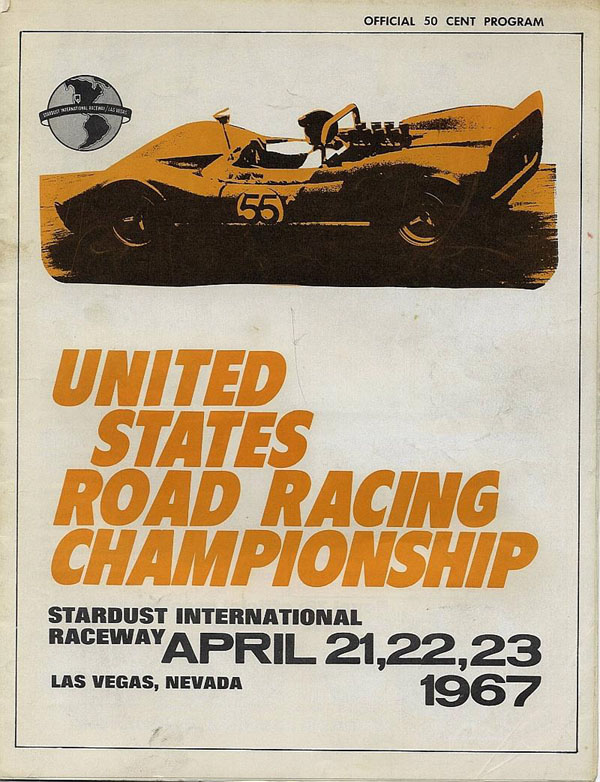
A busy season lay ahead for the HSC McLaren, including the USRRC (where it was the programme cover car for the Las Vegas round), Laguna Seca and Riverside rounds of the Can-Am, and the Santa Barbara Road Races, and Willow Springs Nationals. Adams took victory at the Santa Barbara and Willow Springs events. For the Las Vegas USRRC event at Stardust Raceway, a venue Vandagriff was instrumental in building, the HSC McLaren appeared with a poker chip attached to the front bodywork, where the McLaren logo would normally be applied. This was explained by Cris Vandagriff, Chic’s son: “At one point the people at the Stardust Hotel gave Dad a $10,000 chip to put on the nose. That was when Dad was building the Stardust track”.
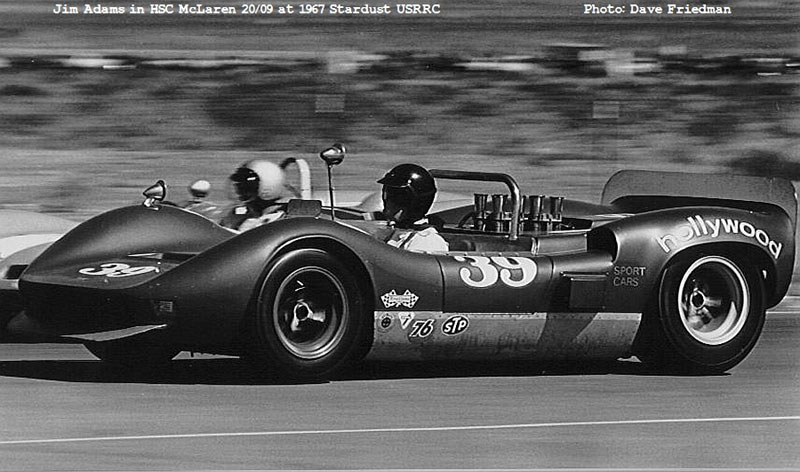
As the season progressed, so too did the McLaren. By the time of the 4th Round of the 1967 Can-Am Championship at Laguna Seca, the HSC machines rear bodywork was bulging to house ever widening wheels and tyres, while an adjustable rear wing was housed within side-fences that swooped up over the rear quarters. This was a period in which Can-Am teams dived headlong into aerodynamic experimentation, to fully embrace the use of manipulating the air passing over and under the cars to better allow them to be pressed further into the tarmac, for increased cornering speeds.
Following its Riverside Can-Am outing, Adams chose to step back from racing for the foreseeable future, and the McLaren was placed on the market. HSC and Spencer built up a McLaren M6B for Jerry Titus to run in the 1968 Can-Am, while in 1969 they ran the Ferrari 612P driven in the Can-Am by Chris Amon (in 1962 HSC and Vandagriff became a Ferrari franchise, and by 1969 was one of the most successful Ferrari dealers in the US). Meanwhile, the HSC McLaren MkI was purchased by Ted West, who soon on-sold it, without motor, to Harvey Lasiter, who otherwise crewed for Lothar Motschenbacher in the Can-Am and USRRC. One of Lasiters sponsors for the former HSC McLaren was the music group The Mama’s And The Papa’s. Lasiter and Doug Hooper both took turns driving the car from 1968, to 1970 in a variety of events including Can-Am and USRRC, with several Lasiter built small block Chevy motors nestled in the back.
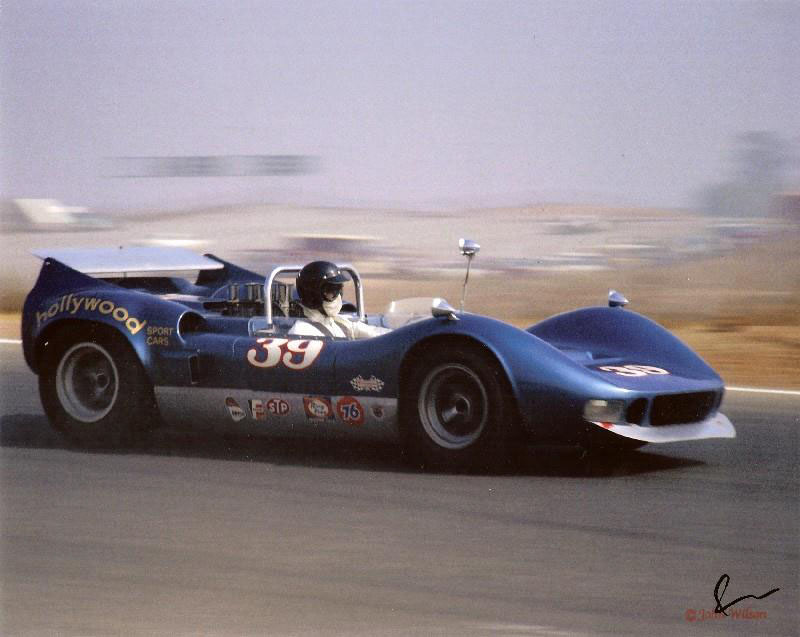
Harvey sold the car to John McDonald, who appears to have used it for a driving school and a few regional races, before it was sold to Mark Dees, then William Robbins. Under the eccentric Robbins’ ownership, the McLaren was converted for street use and road registered, in 1973. This included the fitment of headlights, tail lights, blinkers, mufflers, a horn, and full width windscreen with windscreen wipers.
In 1978, celebrated motoring journalist Eoin Young wrote a feature on the McLaren for Autocar magazine, where he test drove it around local streets and freeways. No doubt this would have been a memorable experience for Young, even given his remarkable career and everything it entailed. As he wrote: “The engine blasted into life on the turn of the key and then I was trying to coax the gearbox into first to the accompaniment of much jarring and grinding from the rear. At last it snicked in and I was driving my very first McLaren racing car, designed and built when I was still a director of the company. I had even done the original negotiations with Trojan that had brought this McLaren-Elva production racer into being”.
“The McLaren was very much a killer shark out of water on the San Diego freeway. My drive was more a jumble of impressions than any considered test”.
“It was a strange sensation to be driving along at hubcap height to the massed ranks of Detroit iron. The mirrors on the front guards were out of adjustment, so I had to stretch round and peer backwards through a forest of Webers to snatch a gap in the traffic. Robbins (who rode alongside Young on the test) was playing Jenkinson to my Moss, reaching across to snatch the trafficators on and off as he anticipated my manoeuvers, switching the electric fans on when the water temperature started to climb”.
-
Administrator

In 1983 the McLaren was purchased by Dan Dubrovich, who converted it back for racing, taking victory (teamed with Bob Akin) in the SVRA 2 hour enduro at Watkins Glen.
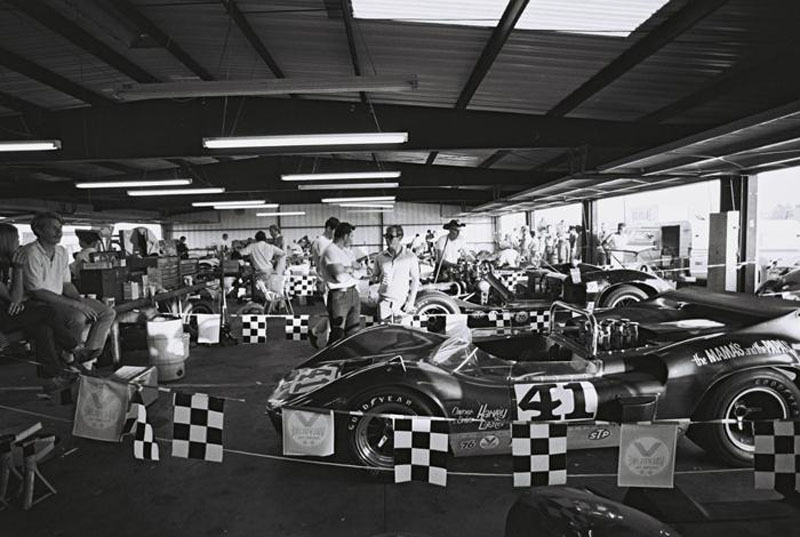
The McLaren was bought and sold a few times during the 1990s, before finally being purchased by current owner Chad Raynal in 2000, to join his wonderful collection of historic racing cars. In 2009, Chad set about giving the McLaren a full nut and bolt restoration, in which only the paint (which was applied in the ‘90s during another restoration) was left untouched. Its condition could only be described as impeccable, and, typically of Chad’s race cars, its history has been fully researched to great detail. Its current configuration is that of its second season of competition, 1967. Its currently fitted with a period correct 331ci small block Chevy, MacKay magnesium intake manifold, quad-48 IDA Webers, backed by an LG-500 transaxle. Overall its in remarkable condition, having never been crashed, butchered or cut up as so many others did.
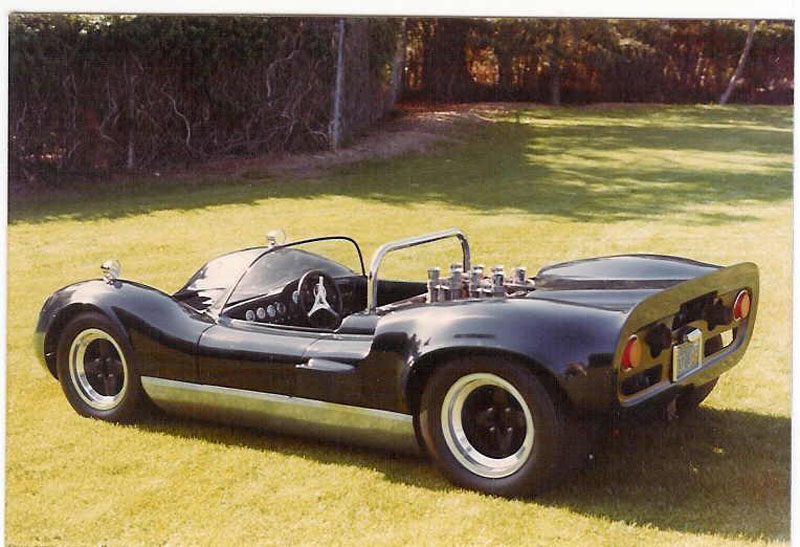
Chad currently has the McLaren for sale. For anyone wishing to purchase a unique race car with a fascinating, colourful history, this is a rare opportunity. With early Group 7 sports cars being accepted into a growing number of international historic events, including the Goodwood Revival and Silverstone Classic, the Hollywood Sport Cars McLaren offers a first-class ticket to some of the world’s most exclusive events.
Doane Spencer went on to achieve great success in US road racing, in Can-Am, IMSA, and other categories, later reuniting with his old mate Jim Adams when the fast peddler returned to racing in 1970, to drive a Spencer prepped Ferrari 512P, and the pair went on to enjoy plenty of success throughout the next decade.
The Spencer fettled McLaren-Elva MkI was typical of the cars he put his hand to. Creative in design, aesthetically beautiful, and with enormous attention to detail. With the fast-pace of development in US Group 7 sports car racing during the 1960s, the HSC McLaren had its best chance at success in 1966. Given Spencer’s pedigree, had the team raced the car more often and with the benefit of further development during that 1966 season, might it have further demonstrated its potential?
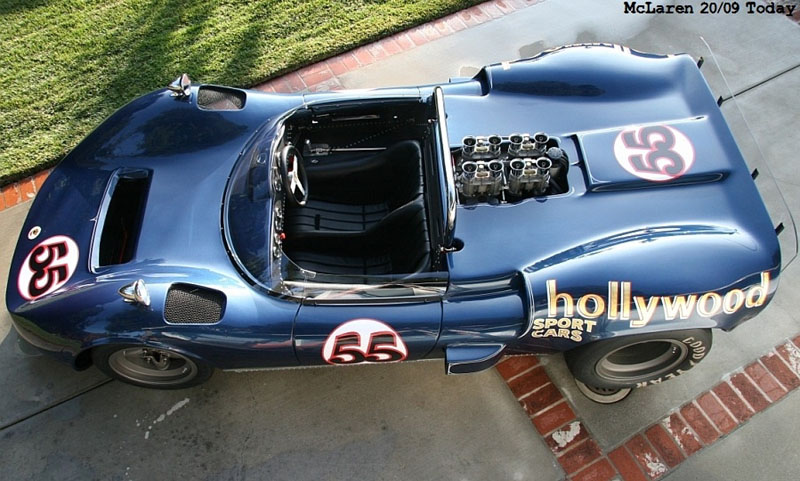
In some respects, the HSC team missed the boat, as by the time they’d further improved the McLaren for 1967, so the competition had upped the game. And so the Hollywood Sport Cars McLaren-Elva MkI remains one of those fascinating tales of the Can-Am, like the Chaparral 2J, Open Sports Ford, and numerous other wonderful creations whose potential greatness was never fully realised, and that might well have gone on to greater things had they hit the ground running at the right time, and made a more significant impact on this very significant racing series.
But the Hollywood Sport Cars McLaren-Elva MkI did go on to lead a fascinating, colourful life, winning races, becoming a road car, and later restored and returned to its most celebrated period, and thankfully survives today in the hands of a caretaker who fully appreciates how special and unique this car is.
For more info on the Hollywood Sport Cars McLaren-Elva MkI, visit: http://www.impeccableinc.com/
Thanks to Chad Raynal for his help with compiling this story, and to Cris Vandagriff, Bob Tronolone, Dave Friedman for supplying the photos. Photos of the bare tub with red paint and alloy sheet applied, and the rear-end shot showing the Ford motor, were both taken at the HSC workshop when the car was in its first stage as a MkI. Both were supplied by Cris Vandagriff.
-
Administrator

Sorry folks the photos don't match up perfectly with the text.
-
Thanks Steve for that!! It is one awsom race car Jamie
-
Administrator

Thanks Jamie, glad you enjoyed it. I know how much you love sports car articles!
-
Administrator

These photos I really love. They were supplied by Cris Vandagriff (Chic's son) to current owner of the McLaren, Chad Raynal. They're scans from slides, taken at the Hollywood Sport Cars workshop when the McLaren was first being 'rebuilt'. They've never been displayed before, so we're extremely lucky to see them.
I choose the word 'rebuilt' for this car, when it was being race prepared for the first time. The second photo posted above in the article shows the McLaren as it was supplied to HSC. These photos detail the amount of work Spencer put into every aspect of the car. Whereas most customer McLaren-Elva's were just given a coat of paint and had a small block Chevy dropped in the back, Spencer absolutely went to town, completely stripping the car down, repainting the chassis bright red, before fabricating up the alloy sheet, which was polished.
Spencer's superb looking 289ci appears on its engine stand, and you can see the magnesium cross-ram intake, but check out also the incredible exhaust header work.
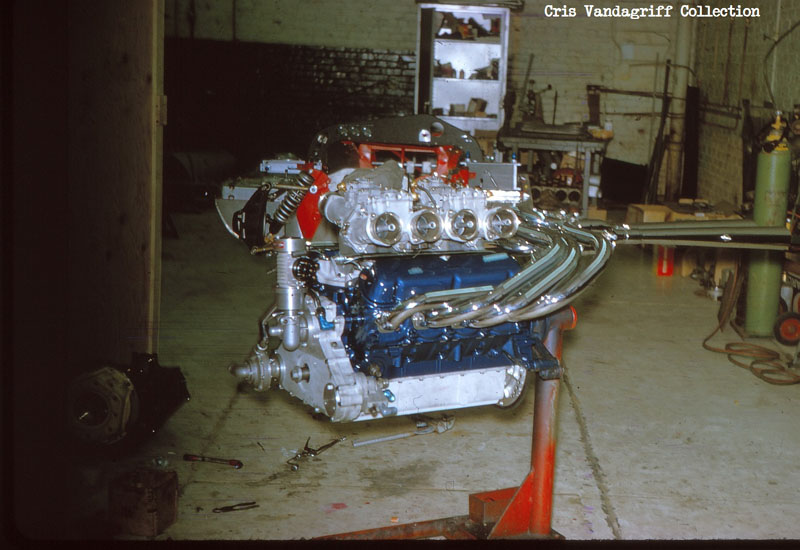
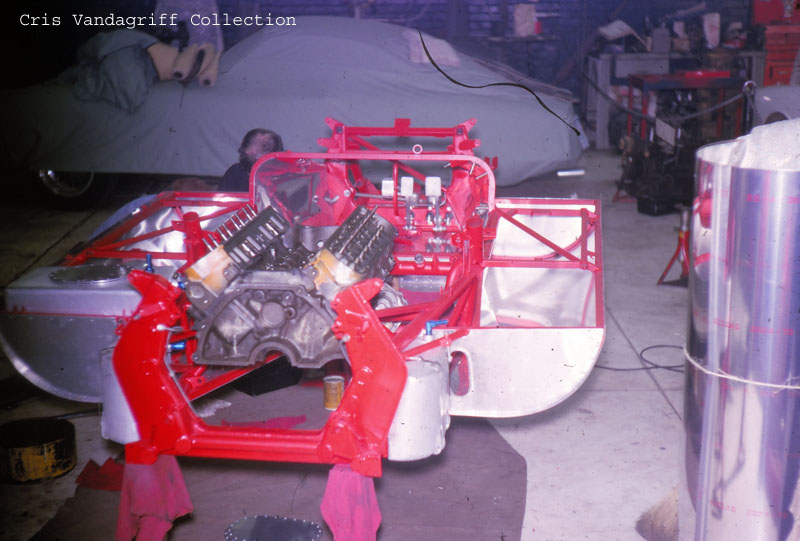
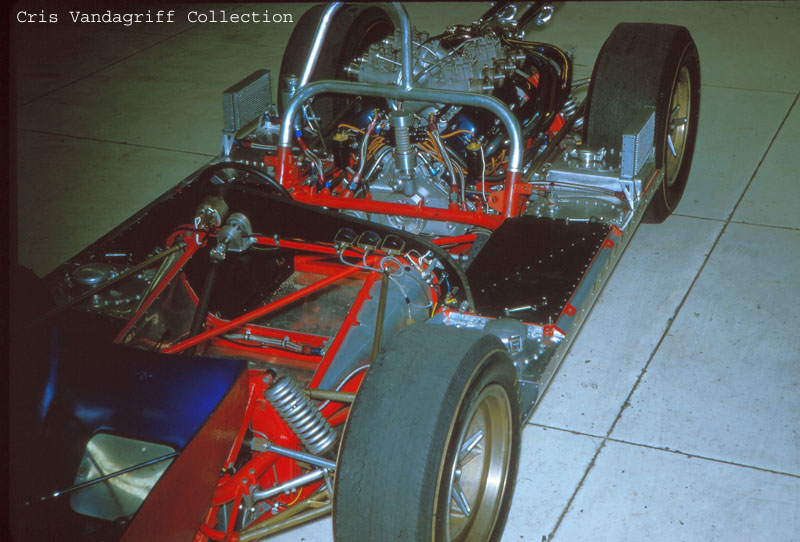
-
Administrator

-
Administrator

-
Steve
Thanks for the excellent article and an insight into a special Sports Car and its owners and builders..
-
Semi-Pro Racer

Another great article Steve and a very historic race car.
-
Administrator

Thanks you guys, glad you enjoyed it. I really have to thank car owner Chad Raynal, as he is the one who did all the hard work compiling so much information on the car, and the photos. I just took all the info he'd gathered and put a few words together.
-
Administrator

Here is another shot of the little Ford motor, with its beautiful cross-ram set-up. Note the chassis in the background.
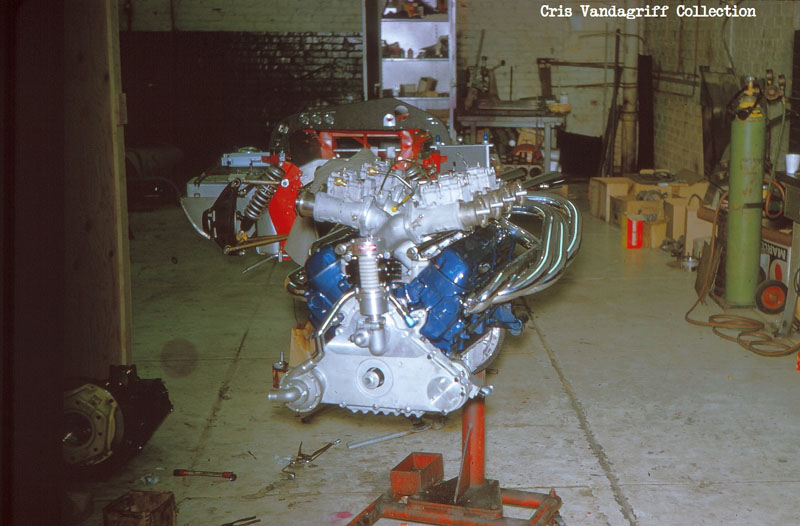
-
Administrator

Here is the McLaren in 1965, in MkI form, during a test session at Willow Springs, with Jim Adams at the wheel.
Compare this photo, after Spencer's work......
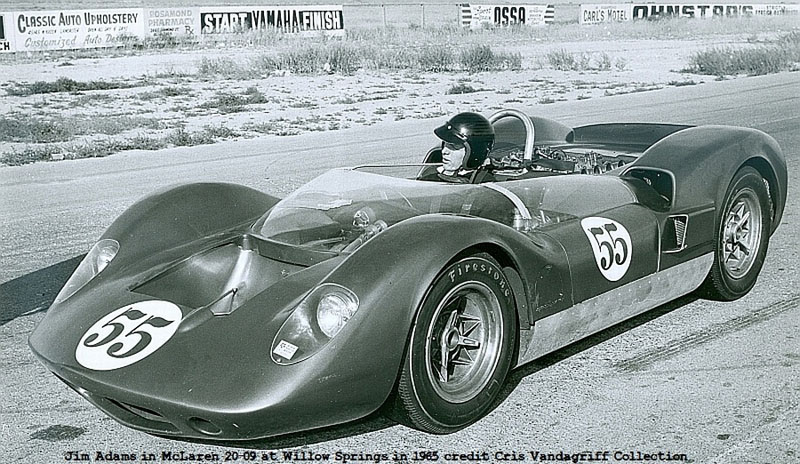
..... to this one, of the car as it was delivered to Hollywood Sport Cars
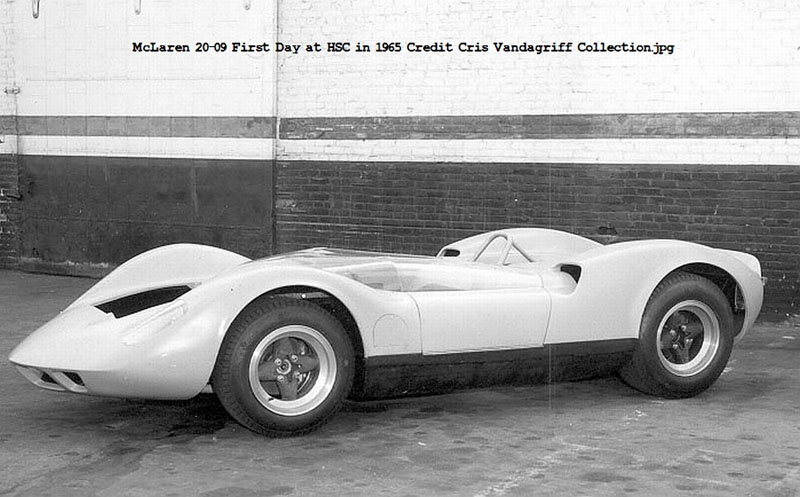
-
what a GREAT article... thanks Steve, awesome work as usual
-
I saw this car up close and personal before it was re-restored, it was super nice then with appropriate patina, now it is just sensational. The level of attention to detail is indication a possible psychiatric disorder. This car is perfect right down to the safety wired nut and bolt level.
I have some close ups and will post them with the owners permission.
Bruce.
-
Sorry to be a pedant, but "McLaren Mk1" is an American term for what the rest of the world calls an M1A...
-
Administrator

Thats right David. I've always referred to them as M1A, M1B etc. In the US they're referred to as both MkI, MkII/M1A, M1B, depending on who you're speaking to. We do have a lot of viewers to this site from the US. I hope my US terminology doesn't cause confusion to readers everywhere else.
-
Administrator

^ ^ That being said, surely M1A was never a factory designation, but something applied with hindsight, after the M1B was released? Would it not have just been named the M1, unless there were always plans to offer a worked over, improved version that would be based on the original model, and didn't receive a completely separate model number? Eg, the Lola T70 MkIIIB was a worked over and improved version of the T70 MkIII, but the T70 MkIII was never named the MkIIIA.
 Posting Permissions
Posting Permissions
- You may not post new threads
- You may not post replies
- You may not post attachments
- You may not edit your posts
-
Forum Rules




 Reply With Quote
Reply With Quote

